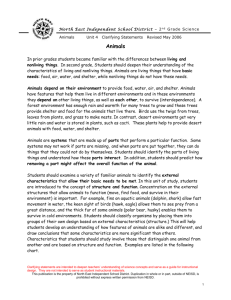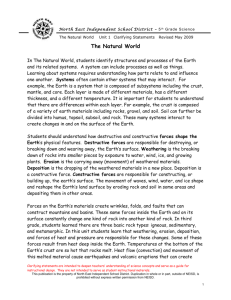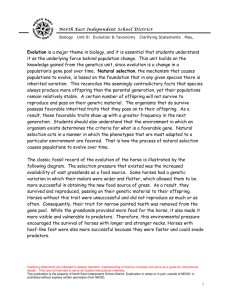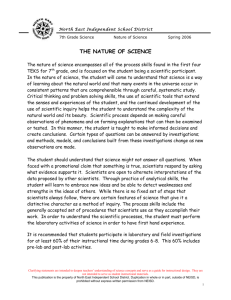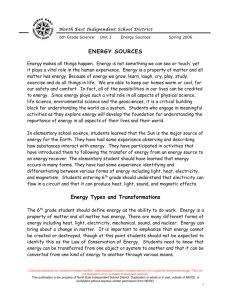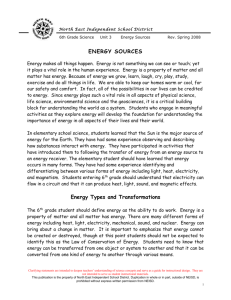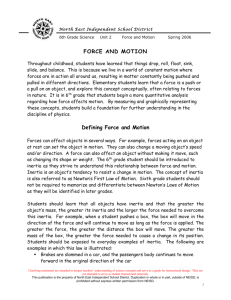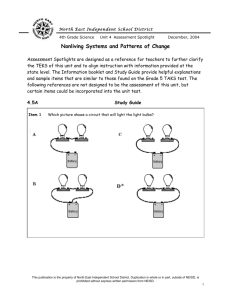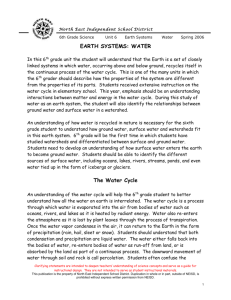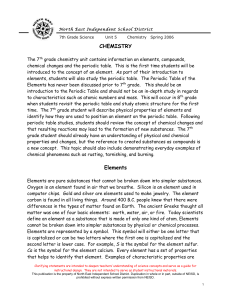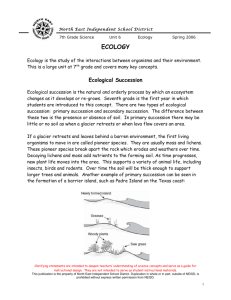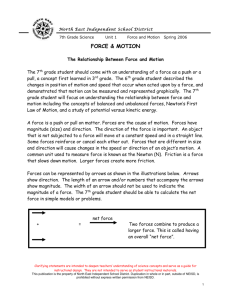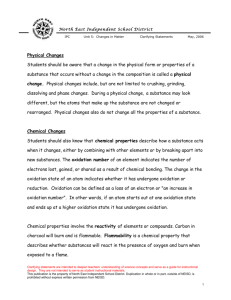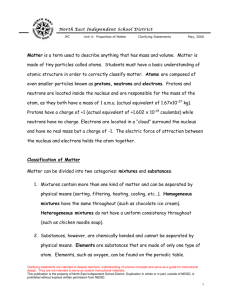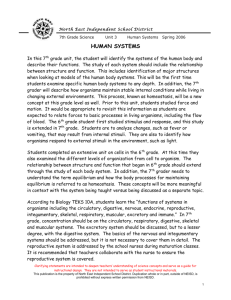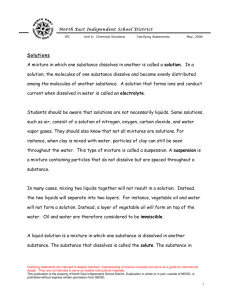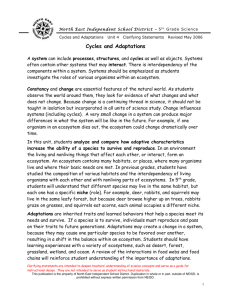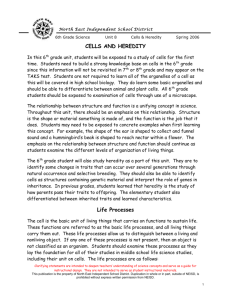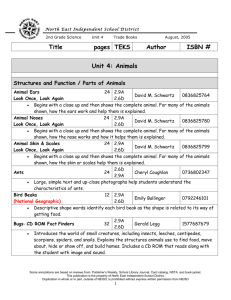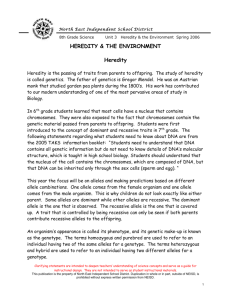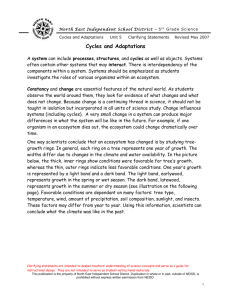Physical Properties - North East Independent School District
advertisement
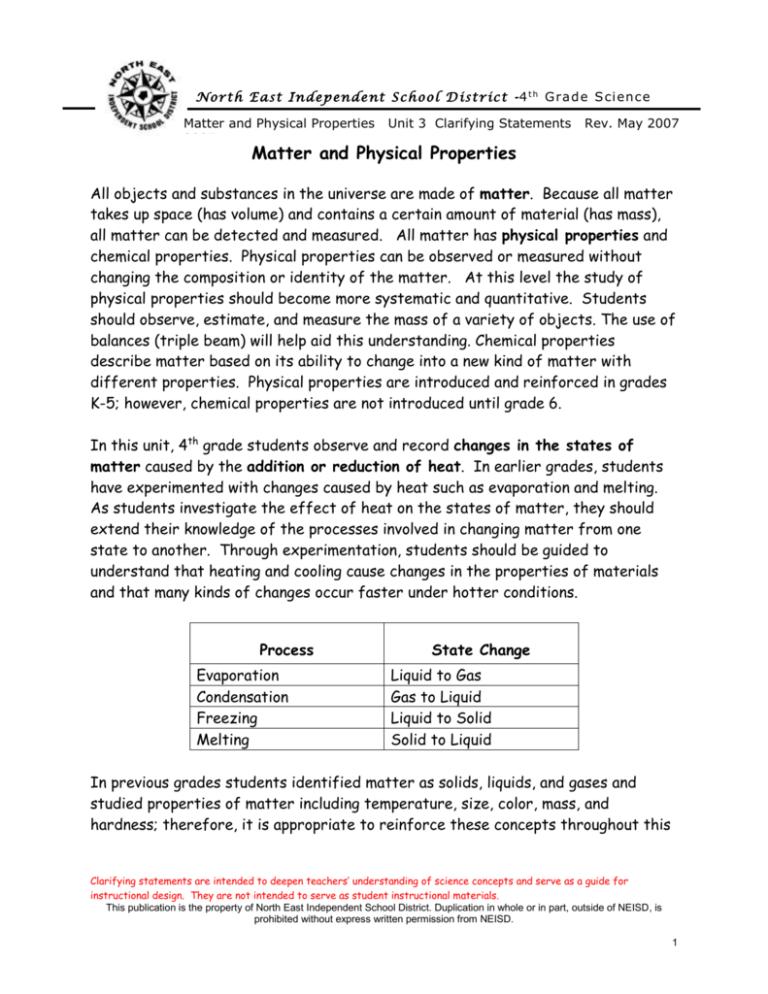
N o r t h E a st I n d ep en d e nt S c h o o l D i st ric t - 4 t h G ra d e S ci en c e Matter and Physical Properties 2005 Unit 3 Clarifying Statements Rev. May 2007 Matter and Physical Properties All objects and substances in the universe are made of matter. Because all matter takes up space (has volume) and contains a certain amount of material (has mass), all matter can be detected and measured. All matter has physical properties and chemical properties. Physical properties can be observed or measured without changing the composition or identity of the matter. At this level the study of physical properties should become more systematic and quantitative. Students should observe, estimate, and measure the mass of a variety of objects. The use of balances (triple beam) will help aid this understanding. Chemical properties describe matter based on its ability to change into a new kind of matter with different properties. Physical properties are introduced and reinforced in grades K-5; however, chemical properties are not introduced until grade 6. In this unit, 4th grade students observe and record changes in the states of matter caused by the addition or reduction of heat. In earlier grades, students have experimented with changes caused by heat such as evaporation and melting. As students investigate the effect of heat on the states of matter, they should extend their knowledge of the processes involved in changing matter from one state to another. Through experimentation, students should be guided to understand that heating and cooling cause changes in the properties of materials and that many kinds of changes occur faster under hotter conditions. Process Evaporation Condensation Freezing Melting State Change Liquid to Gas Gas to Liquid Liquid to Solid Solid to Liquid In previous grades students identified matter as solids, liquids, and gases and studied properties of matter including temperature, size, color, mass, and hardness; therefore, it is appropriate to reinforce these concepts throughout this Clarifying statements are intended to deepen teachers’ understanding of science concepts and serve as a guide for instructional design. They are not intended to serve as student instructional materials. This publication is the property of North East Independent School District. Duplication in whole or in part, outside of NEISD, is prohibited without express written permission from NEISD. 1 N o r t h E a st I n d ep en d e nt S c h o o l D i st ric t - 4 t h G ra d e S ci en c e Matter and Physical Properties 2005 Unit 3 Clarifying Statements Rev. May 2007 unit of study. Density, buoyancy, and conduction are introduced for the first time in this 4th grade unit. The chart that follows outlines some of the properties of matter and explains what students should understand about these properties. Details about the properties introduced at this grade level follow the chart. Physical Properties What It Means (how a substance reflects light) Physical properties can be observed using the senses to identify and describe matter. Temperature The amount of heat in matter (measured in degrees Celsius and Fahrenheit) A change in temperature is a measure of the loss or gain of heat in matter. Scientists generally measure temperature in degrees Celsius. Mass Mass is a measure of the amount of matter in a solid, liquid, or gas. (measured in grams) All solids, liquids, and gases have mass because they are all made of matter rather than energy. In 4th grade, the mass of an object should be measured using a triple beam balance. State of Matter Matter exists as a solid, liquid, or gas Changes in the state of matter are caused by the addition or reduction of heat. Appearance Magnetism Hardness Conduction Color, size, shape, texture, luster What Students Should Understand Ability to attract iron Ability of a substance to resist being scratched Ability of a substance to conduct heat, sound, or electricity Without touching them, a magnet pulls on all things made of iron and either pushes or pulls on other magnets. A harder substance will scratch a softer substance. Heat, sound, and electricity travel better through some substances than they do through others. Clarifying statements are intended to deepen teachers’ understanding of science concepts and serve as a guide for instructional design. They are not intended to serve as student instructional materials. This publication is the property of North East Independent School District. Duplication in whole or in part, outside of NEISD, is prohibited without express written permission from NEISD. 2 N o r t h E a st I n d ep en d e nt S c h o o l D i st ric t - 4 t h G ra d e S ci en c e Matter and Physical Properties 2005 Unit 3 Clarifying Statements Rev. May 2007 Density The amount of matter in a given volume - mass/unit volume (g/ml) When two substances have the same volume, the one with greater mass has greater density. For example, a cup of feathers and a cup of marbles have the same volume, but because the cup of marbles has greater mass it has a greater density. Buoyancy Tendency to float or rise in a fluid (liquid or gas) Buoyancy applies to both liquids and gases and is determined in part by density and fluid displacement. Symmetry One half of an object is a mirror image of the other half. The symmetry of an object does not change when an object is translated, rotated, or reflected. Mass is a measure (in grams) of the amount of matter in a solid, liquid, or gas. Students need many experiences with finding mass. It is not obvious to elementary students that the mass of a whole is equal to the sum of the mass of its parts. Because of this, students need hands on experiences to discover this concept. By finding the mass of piles of small things and then finding the mass of each individual small thing and adding up those masses, students will see that the sum totals the whole, and gain understanding of this concept. Density is a measure that compares how tightly packed the particles are in a sample to other samples of the same volume. Using the appropriate tools, students should have experience comparing and weighing different materials of the same volume to discover that when two substances have the same volume, the one with greater mass has greater density. Density is also useful for predicting whether one substance will float or sink in another. For example when some liquids are mixed (oil and water) they will form a column with the more dense liquid at the bottom (water) and the less dense liquid on the top (oil). Buoyancy is the tendency of objects to float or rise in a fluid (liquid or gas). Buoyant force is the upward force on an object when it is immersed in a fluid. In the case of water, this buoyant force is equal to the weight of the water the Clarifying statements are intended to deepen teachers’ understanding of science concepts and serve as a guide for instructional design. They are not intended to serve as student instructional materials. This publication is the property of North East Independent School District. Duplication in whole or in part, outside of NEISD, is prohibited without express written permission from NEISD. 3 N o r t h E a st I n d ep en d e nt S c h o o l D i st ric t - 4 t h G ra d e S ci en c e Matter and Physical Properties 2005 Unit 3 Clarifying Statements Rev. May 2007 object displaces. As long as the buoyant force (weight of the water displaced) exerted on an object is more than the weight of the object, the object will float. In the same manner, if the buoyant force is less than the weight of an object, the object will sink. Students can experience this force by attempting to submerge a small inflatable toy in a tub of water; the toy seems to push back. An object can be made to float by increasing its buoyant force. Students can experiment to learn that, for example, a clay ball will sink in water, but can be made to float by changing its shape to one that displaces more water. Adding things such as salt to a liquid can also increase buoyant force. Adding air to objects is another way to make objects float. Hands on experiences in a laboratory setting will help students understand this concept. Symmetry can be considered a property of matter in this unit. Symmetry is a pattern in some natural objects that stays the same when it undergoes changes such as rotation, translation, or reflection. Students can observe this constancy by looking at a number of patterns that they have shifted (translated), turned (rotated), flipped (reflected), or seen from different directions. For example a ping-pong ball looks the same no matter how you look at it. This concept is applicable across several disciplines and can be examined using basic shapes in geometry as well as objects from nature. Students should have experience rotating objects (like a spinning top or CD), translating objects (like an ice skater or a billiard ball moving in a straight line, and reflecting objects (like with a mirror or other smooth surface) to see that certain characteristics remain constant even though the object has gone through a change in position. Translation-shift Clarifying statements are intended to deepen teachers’ understanding of science concepts and serve as a guide for instructional design. They are not intended to serve as student instructional materials. This publication is the property of North East Independent School District. Duplication in whole or in part, outside of NEISD, is prohibited without express written permission from NEISD. 4 N o r t h E a st I n d ep en d e nt S c h o o l D i st ric t - 4 t h G ra d e S ci en c e Matter and Physical Properties 2005 Unit 3 Clarifying Statements Rev. May 2007 8 Translations-shift 8 Rotation-turn Reflection-flips Students should also investigate using reflections to verify symmetry. If an object has a line of symmetry, placing a mirror on the line will produce a reflection that looks like the complete object. If a complete object is not produced, the object does not have symmetry along that line. This line is a line of symmetry. If you place the mirror along this line, the reflection will show a half that makes a complete butterfly. Clarifying statements are intended to deepen teachers’ understanding of science concepts and serve as a guide for instructional design. They are not intended to serve as student instructional materials. This publication is the property of North East Independent School District. Duplication in whole or in part, outside of NEISD, is prohibited without express written permission from NEISD. 5 N o r t h E a st I n d ep en d e nt S c h o o l D i st ric t - 4 t h G ra d e S ci en c e Matter and Physical Properties 2005 Unit 3 Clarifying Statements Rev. May 2007 This line is not a line of symmetry. If you place a mirror on this line the reflection would not produce a complete butterfly. Conduction in this unit is emphasized as a property of matter rather than understanding heat and electricity as forms of energy. Students should draw conclusions through laboratory investigations that some matter is better able to conduct heat and electricity than others. For example, metals are better able to conduct heat than wood or plastic. For conduction of heat or electricity to occur the particles in matter must be touching. Convection and radiation are two other ways that heat can be transferred and are discussed in the next unit in the context of systems. Matter that does not conduct heat or electricity well can be considered an insulator. Some materials are better insulators than others. Students also should test various materials to generalize that the same kind of materials that conduct heat also conduct electricity and those materials that do not conduct heat well also do not conduct electricity well. Students can revisit the concept of conduction and apply it to electricity in creating a simple circuit. A circuit is a path through which electricity can flow. For electricity to flow, the circuit must be complete. Using a wire, battery, and small light bulb (such as a flashlight bulb) students should experiment to determine what constitutes a complete circuit. Clarifying statements are intended to deepen teachers’ understanding of science concepts and serve as a guide for instructional design. They are not intended to serve as student instructional materials. This publication is the property of North East Independent School District. Duplication in whole or in part, outside of NEISD, is prohibited without express written permission from NEISD. 6
